The Museum Blog
Category: Family Learning
Growing Ice
by Dan Cox, CMNH Experience Guide
Snowy days might mean no school, but it doesn’t mean that there is nothing to learn. Snow-covered sidewalks helped me learn that salt can melt ice. At the time I didn’t know it was because it lowers the freezing point of water, but I saw the results firsthand through inquiry and observation. I also learned how to use a snow blower, even if I got snow all over my neighbor’s windows. Either way snow days are still an opportunity for learning and here is an experiment you can try.
You will need:
-A couple bottles of water
-A plastic container (You can do it with a small Tupperware but it could probably work with a party cup or even a bowl. You want something that has some room in case of spills)
-Some ice cubes
-Food coloring (Optional for fun colors)
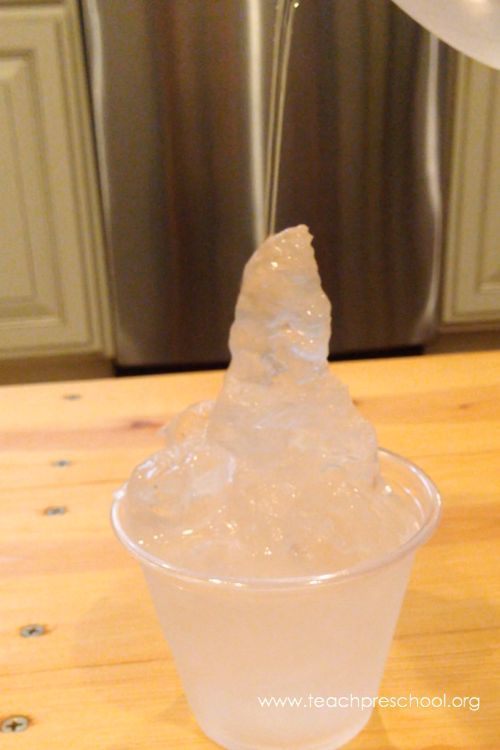 1. First you want to put the bottles of water in the freezer, if you decide to add food coloring make sure to screw the cap on tightly.
1. First you want to put the bottles of water in the freezer, if you decide to add food coloring make sure to screw the cap on tightly.
2. Leave the bottles in the freezer for about 2 Hours and 45 Minutes. Check them regularly because you don’t want them to freeze. (When I used to do hiking in the winter, I would place my water bottle upside down. Ice floats {because it’s less dense} and it will freeze from the top down)
3. When the water in the bottles is super cold, but not frozen, take them out of the freezer.
4. Next you want to place some ice cubes in the plastic cup.
5. Then pour the cold water on the ice.
6. Observe what happens, will the water melt the ice? Will the ice freeze the water?
Here is a youtube video of someone else trying this experiment:
Snow Day Literacy Fun
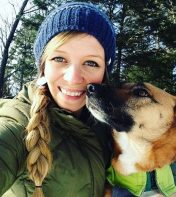
Snow Day?
It's a great time for some literacy fun!
I had a lovely snow day today—snuggled into my apartment with my sleepy pup, catching up on work, and sipping coffee—it was so relaxing. I couldn't help but think of the snow days when I was a kid and how different a snow day is now that I'm an adult.
It was always exciting to have a surprise day home from school. The morning would be a whirlwind of “helping” shovel (aka my brother and I throwing snow at each other with our shovels), making pancakes and hot cocoa, sledding, building forts and snow-people, chasing each other around and subsequently destroying the pristine, beautiful, winter wonderland from the storm the night before. Sounds like a full day of fun, no? We would usually finish all of these activities before noon and then start complaining to my parents that we were SOOOOO BOREDDDDDDDD!
So, I've put together a few activities to help with that afternoon snow day boredom. And for a bonus—they're all related to literacy! It's a sneaky way to fit in some learning on a day off.
Five Literacy Activities for a Snowy Day:
1. Find a favorite winter story like “The Mitten” by Jan Brett and read it together as a family. Then find ways to re-tell the story!
- Find stuffed animals that match the animals in the story and hide them all inside a big white pillow case—try to remember the order that the animals climbed into the mitten!
- Print photos of the animals off the Internet, spend some time comparing the photographs to Brett's beautifully drawn animal illustrations in the book—how are they alike or different?
- You can use these photographs to re-tell the story as well—put the photos on sticks or straws and use them as puppets.
2. Get outside! Try snow painting.
- Find a few spray bottles and fill them with water. Add some food coloring or liquid water color and go outside and play!
- You can practice writing letters and then drawing something that begins with that letter.
- You can provide your child/ren with just primary colors and allow them to experiment and try to make different colors—chat with them about their process and what they have discovered!
- If your child/ren are older, challenge them to each draw a series of pictures that tell a story, then challenge them to re-tell each other's stories. Then they can share with each other the story they were actually trying to tell—there will be lots of giggles!
3. Go on a letter hunt inside the house (or outside!) Give your child a piece of paper with a big letter written on it and have them go around and find everything in the house, or a certain room of the house, that begins with that letter. It'll become an exciting scavenger hunt for your child and very little work for you! If your child is not recognizing letters or letter sounds yet—try this scavenger hunt using color instead. Older kids? Try a rhyme hunt!
4. Write each other secret notes—or create secret drawings. This one is really easy! Take a white crayon (you know, the most neglected crayon in the box!) and write a note or draw a picture on a white piece of paper. Then paint over the paper with watercolor. Read your note to your child or have them read it to you—and have them explain their drawing.
5. Make a snow day treat together. Following recipes is a terrific way to start understanding sequencing and improve narrative skills. Reading the recipe and then putting it all together will be challenging, but an excelling literacy experience—and the reward of a tasty treat is pretty good too! If your child/ren are older let them do this with a low level of supervision. Tell them if they work together and carefully follow the recipe—you'll do all the dishes!
I hope you enjoy these snow day activities! Let us know if you try any of them and if they help to combat the snow day afternoon boredom. I'm off on a snow shoe with Bella the pup--who finally woke up!
Dog's Colorful Day: Our Family Literacy Month Book!

Why “Dog’s Colorful Day”?
As the Literacy Coordinator here at The Children’s Museum I had the exciting task of picking the book we would be giving away to visitors as part of our Family Literacy Month celebration.
This might sound like a simple task. I adore picture books and use them as much as possible in all the programs I do here at the museum. I go to the library to pick out a few books for a specific class and always come back with about 12 more than originally planned. I can’t help myself!
However, this book buying was different. I wanted to choose a book that had great illustrations and a fun story--- I wanted the book to be entertaining for adults as well as children, I wanted it to prompt fun conversations among families and become a favorite to be enjoyed over and over again. I wanted it to be a book that could be appreciated by a grandparent, a teenage babysitter, an 18 month old or a nine year old—or even better—all of those people together!
Needless to say, it took me a very (very) long time to select a book.
The book I ended up picking is “Dog’s Colorful Day” by Emma Dodd.
This is a story of a busy little dog that goes on a colorful adventure and ends up getting into all kinds of messy trouble—teaching colors and numbers along the way. School Library Journal calls it “A multifaceted concept book and a charming story to boot!” I couldn’t agree more.
Here’s why I think “Dog’s Colorful Day” is a perfect fit for Family Literacy Month—and how you might like to use it with your family:
For reading with Babies:
- The book has clear illustrations that are easy for baby’s eyes to see and understand—there are many familiar shapes that appear in the book (shoe, ball, table, clouds). These are great to point out to baby--it will help them understand the world around them. Point these items out in the book while you read and then find real life examples.
- There are wonderful onomatopoeic words (Splat! Splish! Squash!) These playful words will resonate in baby’s ears and help them learn the sounds of our language.
- It’s a lovely and fun introduction to colors and numbers.
For reading with Toddlers & Preschoolers:
- This book is perfect for reading with the toddler & preschool age group—be sure to ask lots and lots of questions while you read—“What do you see on this page that Dog might get into? What color spot do you think he will get? Can you help me count Dog’s colorful spots?”
- As you read the book—point out the different colors of spots that Dog has—ask your toddler or preschooler if they can remember how Dog got each of his colorful spots. This activity will reinforce narrative skills—one of the most important pre-reading skills!
Reading with Older Children:
- This book has many familiar words that children starting to read will recognize. The pictures also lend themselves well as clues to help figure out what the words on the page say.
- Use it as a math activity! Ask your older child “If I wiped off Dog’s pink spot and blue spot—how many spots would he have left?”
- Do an art activity when you finish reading the book—have your child draw a picture of dog and then add all of his colorful spots.
I hope you enjoy “Dog’s Colorful Day” as much as I do. It’s a splendid book to read together as a family and has lots and lots of potential for literacy activities at home.
If you do enjoy “Dog’s Colorful Day”---Emma Dodd has written two more books about the adventures of Dog—“Dog’s ABC’s” and “Dog’s Noisy Day”. What kind of trouble will Dog get into next? Sounds to me like a good reason to pile into the car and head to the library!
We would like to give an extra special "Thank You!" to our Family Literacy Month sponsors for making these book giveaways possible:
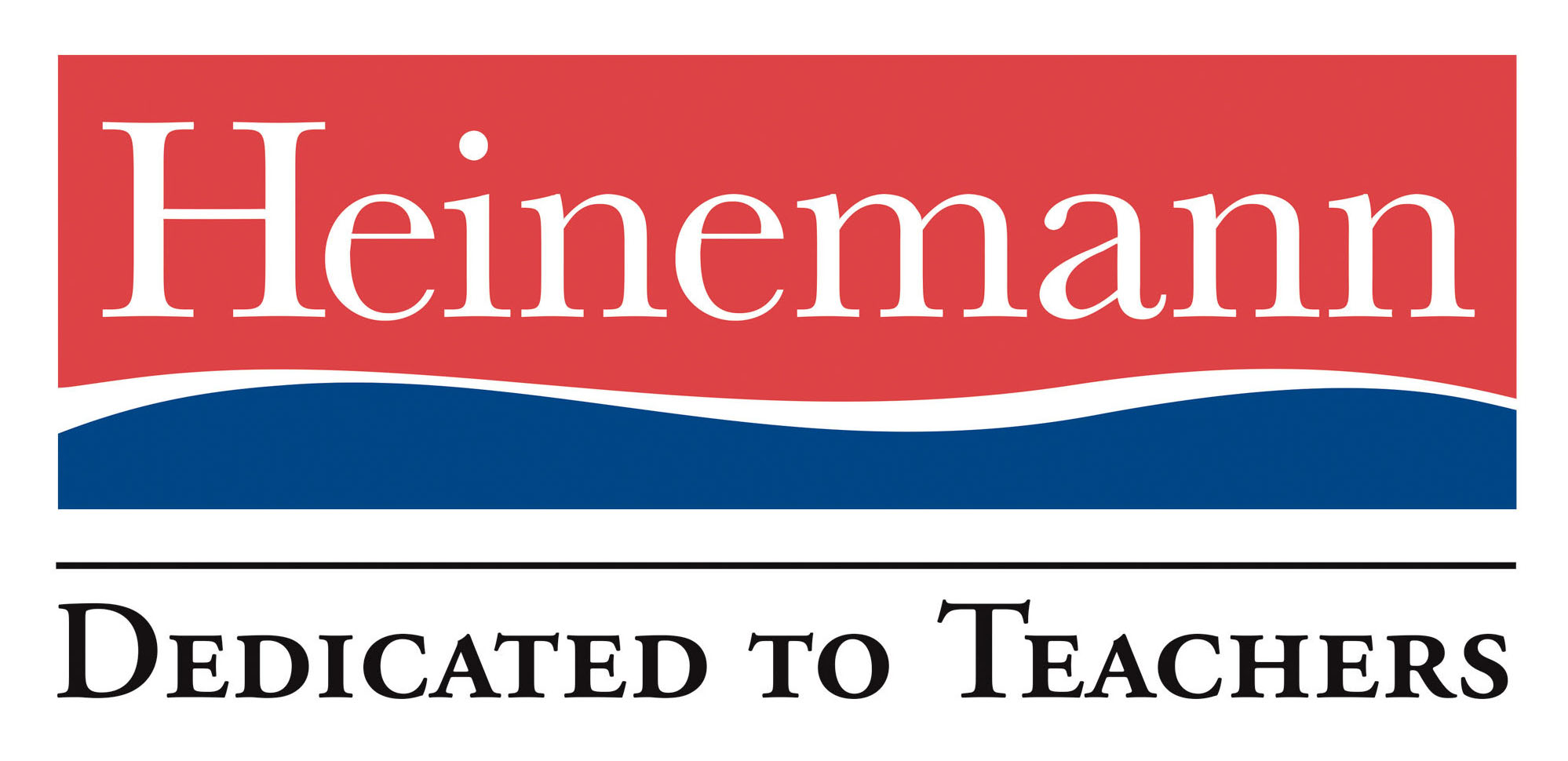


Happy Reading!
-Meredith
meredith@childrens-museum.org
Shaky Eggs
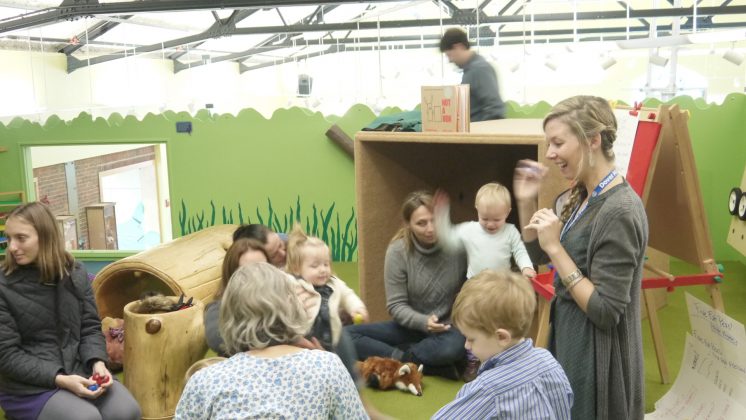
by Meredith Lamothe, Early Childhood and Literacy Coordinator
We were making shaky eggs the entire first week of our Toddlerfest celebration. Shaky eggs or egg maracas are a great first percussion instrument for little ones and a fun way for them to feel included in making music as well as get a good introduction to rhythm, which is an important early literacy skill!
There are lots of songs that can be used with shaky eggs—actually, you can shake along to most any song you like or listen to---but there are a handful of songs that I use regularly in Baby Storytime here at the museum that highlight shaky eggs and are a lot of fun.
Here’s a few you can try at home!
Counting Shakes: (Tune: "If You’re Happy and You Know It")
If you’re happy and you know it shake your egg—one time!
If you’re happy and you know it shake your egg—two times!
If you’re happy and you know it and you really want to show it, if you’re happy and you know it shake your egg—three times!
(Keep going for however long the focus lasts!)
Shake, Clap, Tap! (Tune: "If You’re Happy and You Know It")
If you’re happy and you know it give a shake
If you’re happy and you know it give a shake! (etc)
If you’re happy and you know it give a clap!
If you’re happy and you know it give a clap (etc)
If you’re happy and you know it give a tap (tap your egg on a surface or part of your body)
If you’re happy and you know it give a tap (etc)
If you’re happy and you know it give a shake! And a clap! And a tap!
Shake Your Shaker! (Tune: "London Bridges")
Shake your shaker way up high, way up high, way up high
Shake your shaker way up high
Shake your Shaker
Shake your shaker…
Way down low
To the left
To the right
On your foot!
On your head
Really fast
Really slow
Etc!
That’s just a sampling of the egg shaker songs we do during Baby Storytime—stop by on Wednesdays at 9:30am in Primary Place to see the other ways we use them.
Shakers can also be used as an early reading and literacy tool. Bump them along the pages of a book to point out the different words, sound out familiar words and names using the eggs to accentuate the different syllables, or read a book that lends itself to music (Pet the Cat anyone?) and have your shaky eggs ready for the grooviest parts of the book!
How will you use your egg shaker at home?! Let us know!
Teddy Bears (and more) get a Checkup!
Teddy Gets a Checkup at Our Teddy Bear Clinic
By: Amanda Girard, CMNH Intern
It's that time of year again! Our Teddy Bear Clinic is coming up on Friday, August 5 2016. This is one of our favorite events that we’ve been doing for over 25 years! At last year's clinic we talked to many families who have made it a tradition to come every summer. One family we talked to has actually cancelled hair appointments to go to our Clinic!
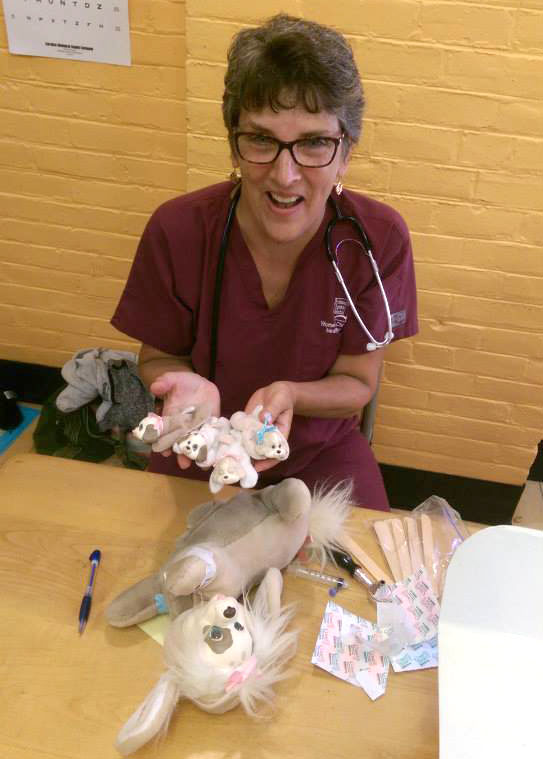 “It’s the cutest idea!” was something that I heard a lot during the last clinic as visitors checked in their patients. After getting an ID bracelet with their name on it (names ranging from "Stuffy" and "Bunny" to "Who Who" the owl and many, many others) and a short wait in the waiting room, each animal was ready to visit one of our volunteer doctors from Portsmouth Regional Hospital.
“It’s the cutest idea!” was something that I heard a lot during the last clinic as visitors checked in their patients. After getting an ID bracelet with their name on it (names ranging from "Stuffy" and "Bunny" to "Who Who" the owl and many, many others) and a short wait in the waiting room, each animal was ready to visit one of our volunteer doctors from Portsmouth Regional Hospital.
Stuffed animals were weighed and measured and some got stitches, Band-Aids and stickers too. Last year, we even had a patient named “Doggie” become a Mom to 4 puppies, a first for our clinic!
Even though it’s called a “Teddy Bear Clinic,” visitors brought more than just bears! Tigger, a giant frog,
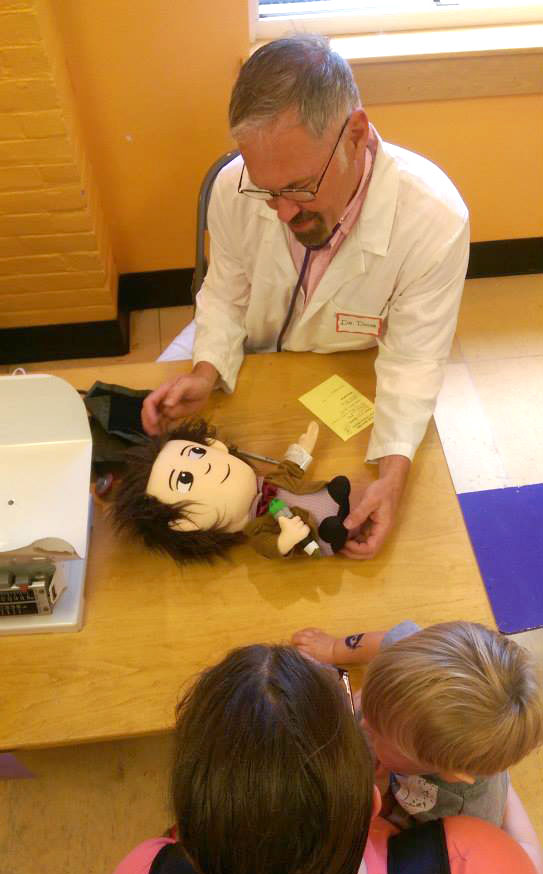
colorful birds, Clifford the Big Red Dog, a cat mermaid, Pluto, horses, unicorns, and even Dr. Who were just some of the many unique patients!
“The variety is always something that gets me,” said Zach, a Museum staff member. “I mean, there are plenty of Teddy bears, but also snakes, cats, dogs and more. Dr. Who is a first though!”
The event also helped kids who may be a bit anxious about visiting the doctor. “It makes kids more comfortable with the idea of going to the doctor,” one of our volunteer nurses explained. “Seeing that a needle doesn’t hurt Teddy can help kids who may be afraid of needles.” If their stuffed friend can make it through a trip to the doctor, then they definitely can!
Afterwards, visitors played with their dogs, Teddy Bears, cats and bunnies throughout the Museum until our Teddy Bear Picnic where everyone enjoyed juice, fresh fruit and animal crackers on a beautiful day in Henry Law Park!
We hope you can join us for this year's Teddy Bear Clinic!
Four & Twenty Blackbirds
The Caldecott Medal in the 1970's
Welcome to Four & Twenty Blackbirds, CMNH's blog series on the history of the Caldecott Medal and the children's book illustrations that have been fortunate enough to be honored and awarded by the Caldecott committee.
We're now entering one of the most enigmatic decades of the 20th Century. The tumultuous events of the previous decade spiral into the beginning of the 1970's and form cultural rivulets leading to political and economic upheaval, a renaissance in American film and the ascendancy of disco, punk and progressive rock music. The bright eye-popping color palette of the previous decade falls away to the earthier tones of what became known as the "Me Decade." The 70's earned the "Me Decade" nickname due to the overwhelming impression that the younger generation, unlike the one before them, was more interested in their own lives than the world at large.
A quick glance at the Caldecott Honorees and Medal Winners from the decade couldn't paint a more different picture. Of the ten books whose illustrators won the Caldecott Medal for elevating the work to the status of, "most distinguished American picture book for children," seven of them directly dealt with other cultures, religions and ways of life far removed from the average American child that was the likely target audience for these stories when they were published. African folktales - with an extra emphasis on the Ashanti and Swahili cultures - popped up repeatedly among the honorees and winners throughout the decade, as did Jewish legends, Pueblo mythology, the Quaker movement, Japanese fairy tales and Native American life.
Let us now look at some books from the grand, misunderstood decade that was the 1970's. A book about amphibian friendship. A book about a donkey. And a book about a witch.

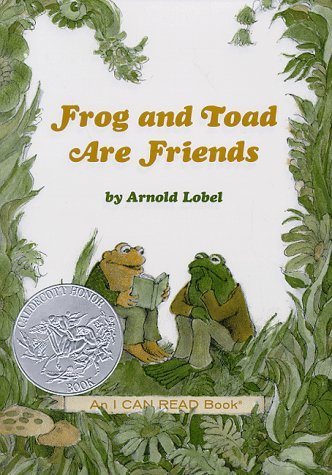 Who: Arnold Lobel (born in Los Angeles, CA, 1933)
Who: Arnold Lobel (born in Los Angeles, CA, 1933)
Book: Frog and Toad are Friends / Harper & Row / 1970
Writer: Lobel
Plot: This beloved children's book was Lobel's tenth published work and the first of the "Frog & Toad" books - the series that made Arnold Lobel a household name. Broken up into five short stories - "Spring", "The Story", "A Lost Button", "The Swim," and "The Letter" - take a look at the simple every day lives of the more adventurous Frog and his reserved, but stalwart, friend, Toad. Many children and parents used Frog and Toad are Friends as a jumping off point to talk further about subjects as diverse as forgetfulness ("The Lost Button"), sadness and happiness ("The Letter"), body image/changes and shyness ("The Swim"), restlessness ("Spring") and, expectedly, friendship ("The Story").
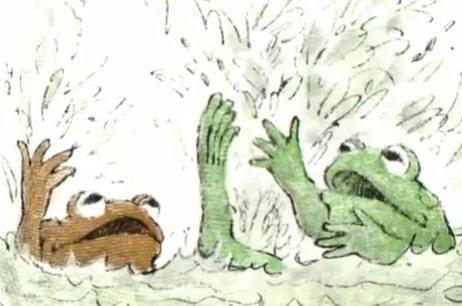
Misc: Frog and Toad are Friends was named as a runner-up for the Caldecott Medal when the honored list of books was announced in 1971. But Lobel had good company as Maurice Sendak's In the Night Kitchen and Blair Lent's The Angry Moon were his fellow runners-up. Gail E. Haley's A Story a Story was named the Caldecott Medal winner for the 1970 class of nominees. Lobel would again be named as a Caldecott runner-up the following year for 1971's Hildilid's Night and would finally win the prestigious award ten years after his first nomination for 1980's Fables. Lobel went on to write and illustrate three more Frog & Toad books: Frog and Toad Together, Frog and Toad All Year and Days with Frog and Toad. Years after Lobel's untimely death (he passed in 1987), his daughter Adrianne colored three uncolored manuscripts of his that were found in an estate sale and were released in 2009 as The Frogs and Toads All Sang and Odd Owls and Stout Pigs: A Book of Nonsense.
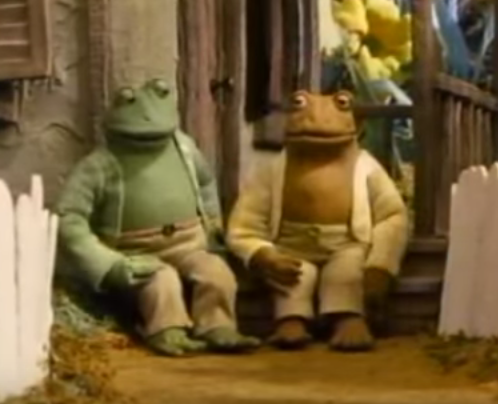
Many children who became acquainted with Frog and Toad in the 1970's and 80's may recall a series made by Churchill Films that adapted the first Frog and Toad books into 20 minute claymation shorts. The series was narrated by Lobel. A Year with Frog and Toad, a musical, premiered on Broadway in 2003. Commissioned by Adrianne - who also designed the set - the stage production was adapted by her husband, actor Mark Linn-Baker, who also went on to play Toad in the original cast. In 2012, the School Library Journal listed it at #15 on their list of the, "Top 100 Picture Books".
Availability: Frog and Toad are Friends, as well as the entire Frog and Toad series, is available in paperback, hardcover and digital formats as well as larger collected editions of the complete series.
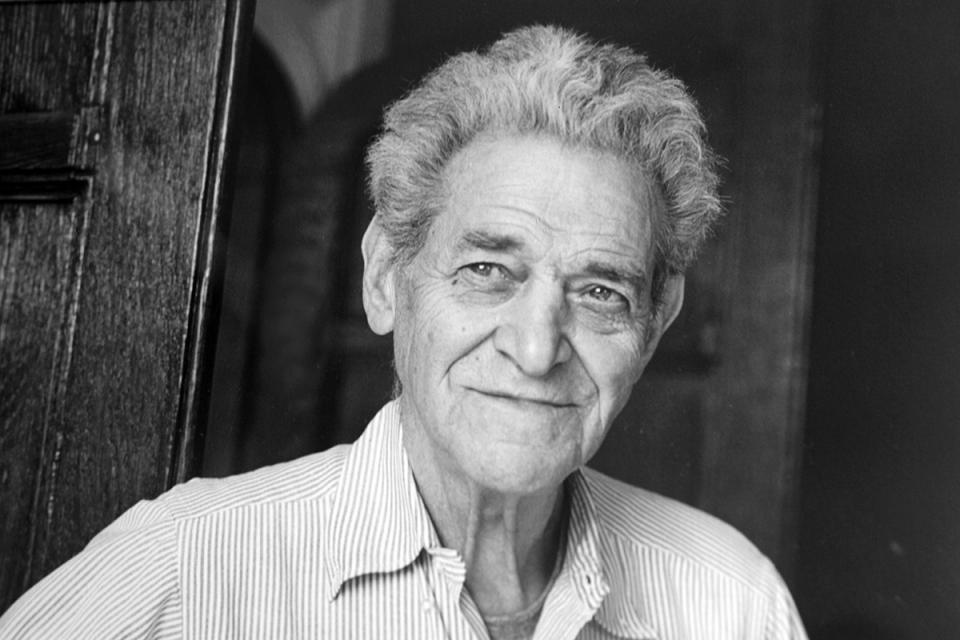 Who: William Steig (born in Brooklyn, NY, 1907)
Who: William Steig (born in Brooklyn, NY, 1907)
Book: Sylvester and the Magic Pebble / Windmilll Books / 1969
Writer: Steig
Plot: Sylvester is a donkey. Sylvester lives in the town of Oatsdale. One of Sylvester's favorite hobbies is collecting rocks, stones and pebbles. The more unusual and strange the rock, the more Sylvester wants it 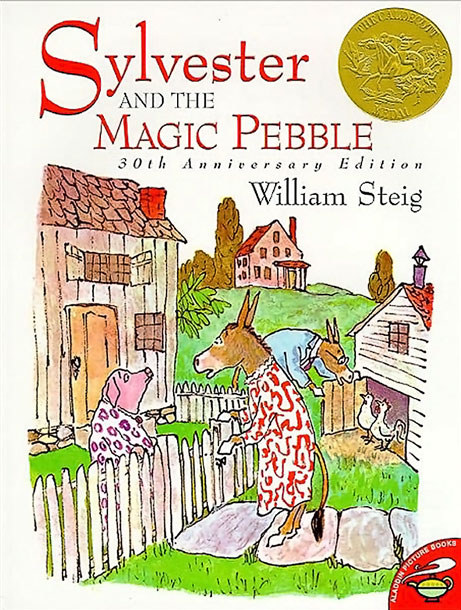 for his collection. One day, Sylvester comes across the strangest piece of sediment he's ever seen: a magic pebble! This pebble grants wishes and Sylvester can't wait to try it out. Unfortunately, a frightening lion crosses Sylvester's path before he can get to his wishes and in his scared state, Sylvester quickly wishes he was a rock in order to hide from the lion. *POOF* Sylvester's wish is granted. But in becoming a rock, Sylvester loses contact with the pebble. Without physically touching the pebble, he can't wish
for his collection. One day, Sylvester comes across the strangest piece of sediment he's ever seen: a magic pebble! This pebble grants wishes and Sylvester can't wait to try it out. Unfortunately, a frightening lion crosses Sylvester's path before he can get to his wishes and in his scared state, Sylvester quickly wishes he was a rock in order to hide from the lion. *POOF* Sylvester's wish is granted. But in becoming a rock, Sylvester loses contact with the pebble. Without physically touching the pebble, he can't wish 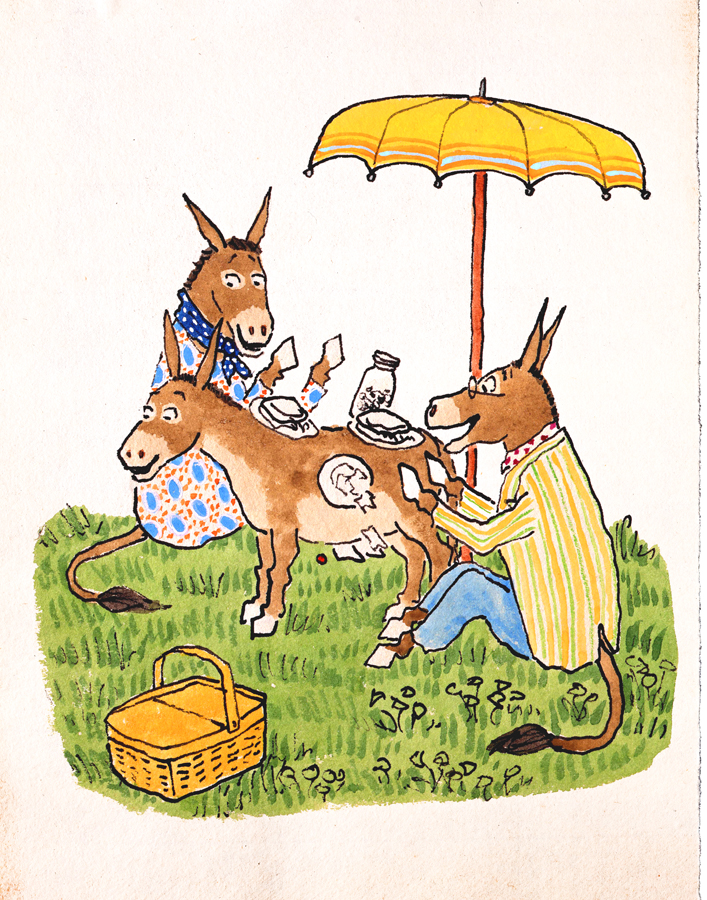 himself back to his donkey form. Will Sylvester be trapped as a rock forever? Will Sylvester's mom and dad ever find their son? And what will happen to the magic pebble?
himself back to his donkey form. Will Sylvester be trapped as a rock forever? Will Sylvester's mom and dad ever find their son? And what will happen to the magic pebble?
Misc: You already know Steig even if you've never read Sylvester, which, in addition to winning the Caldecott Medal in 1970 was also a finalist for the National Book Award. And maybe you've never read The Amazing Bone, his Caldecott Honor book from 1976 or Doctor De Soto, a 1983 National Book Award winner (an award shared with multiple Caldecott winner Barbara Cooney for Miss Rumphius). His biggest contribution to the pop culture landscape, and what made him a household name eleven years after it was written, was a small book from 1990 titled Shrek!. 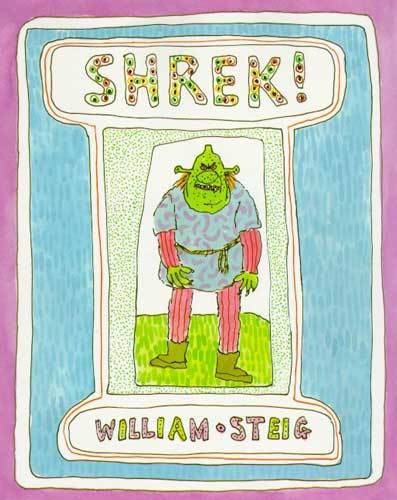 Perhaps you've heard of it? And the four film franchise it spawned? Going on to win the inaugural Academy Award for Best Animated Feature? But while Shrek!, both the book and the films, have been generally well loved by the populace, Sylvester and the Magic Pebble ran across some controversy not long after it was published. Despite eventually being named as one of the "100 Best Books of the Century" by the National Education Association, upon its release Sylvester saw many school districts and
Perhaps you've heard of it? And the four film franchise it spawned? Going on to win the inaugural Academy Award for Best Animated Feature? But while Shrek!, both the book and the films, have been generally well loved by the populace, Sylvester and the Magic Pebble ran across some controversy not long after it was published. Despite eventually being named as one of the "100 Best Books of the Century" by the National Education Association, upon its release Sylvester saw many school districts and 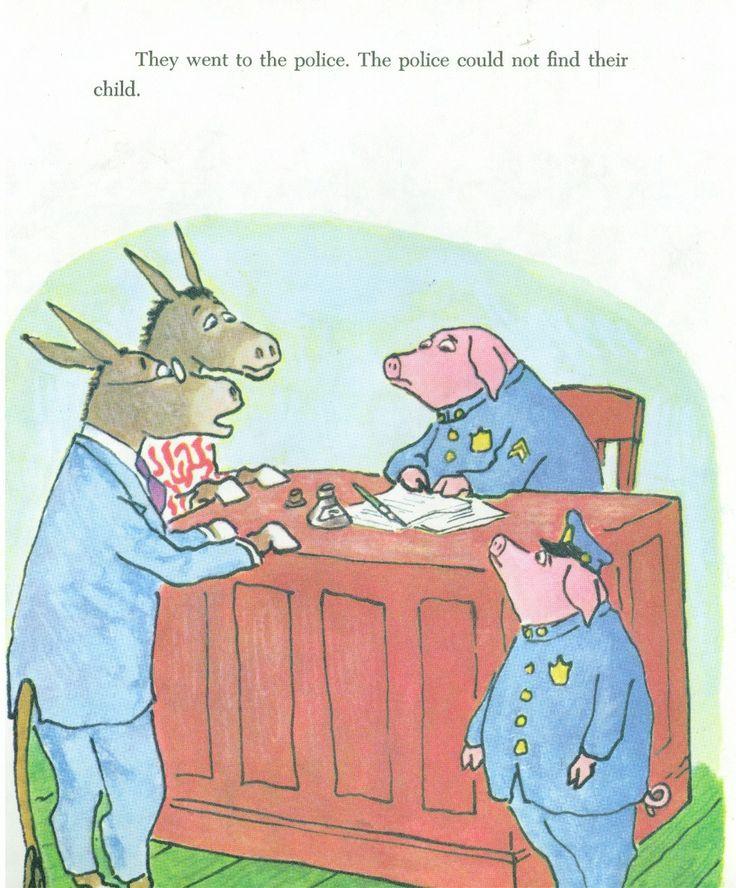 organizations challenge the book due to the fact that police officers in the town of Oatsdale were portrayed as pigs. The popular defense of the book pointed out that several different professions in Oatsdale were represented by pig employees, but that still caused Sylvester to be seen as subversive for its time. Younger children (pre-K) may have some issues with the possibility that Sylvester and his parents may never reunite and the twist of magic gone wrong (the staple of oh-so-many fables) might cause anxiety in those that aren't used to this fairy tale trope. Regardless, a William Steig picture book is a necessity in any family library. Luckily, he wrote nearly three dozen books just for children - the majority of which are still in print.
organizations challenge the book due to the fact that police officers in the town of Oatsdale were portrayed as pigs. The popular defense of the book pointed out that several different professions in Oatsdale were represented by pig employees, but that still caused Sylvester to be seen as subversive for its time. Younger children (pre-K) may have some issues with the possibility that Sylvester and his parents may never reunite and the twist of magic gone wrong (the staple of oh-so-many fables) might cause anxiety in those that aren't used to this fairy tale trope. Regardless, a William Steig picture book is a necessity in any family library. Luckily, he wrote nearly three dozen books just for children - the majority of which are still in print.
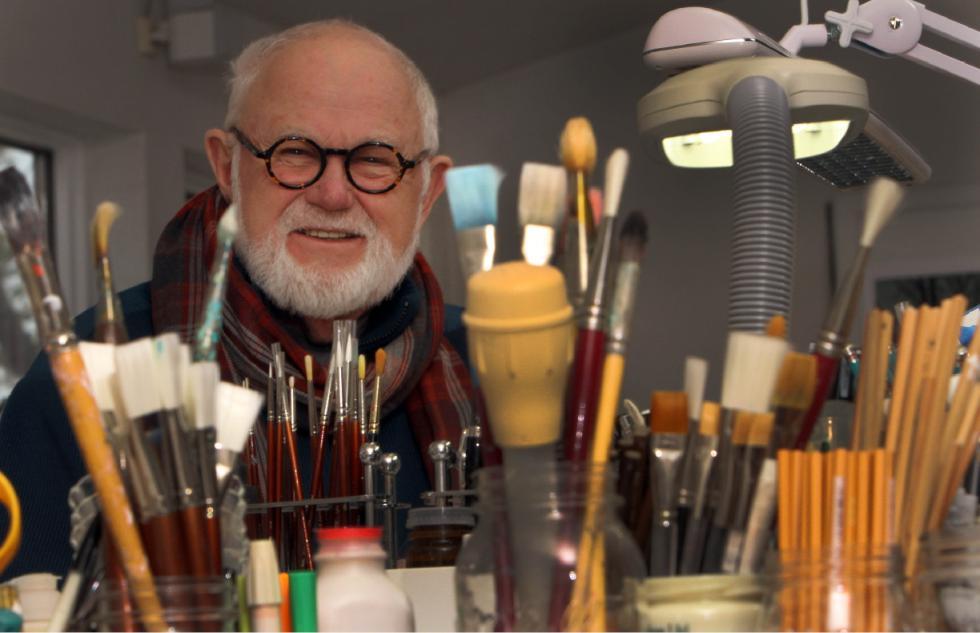 Who: Tomie dePaola (born in Meriden, CT, 1934)
Who: Tomie dePaola (born in Meriden, CT, 1934)
Book: Stegra Nona / Simon & Schuster / 1975
Writer: dePaola
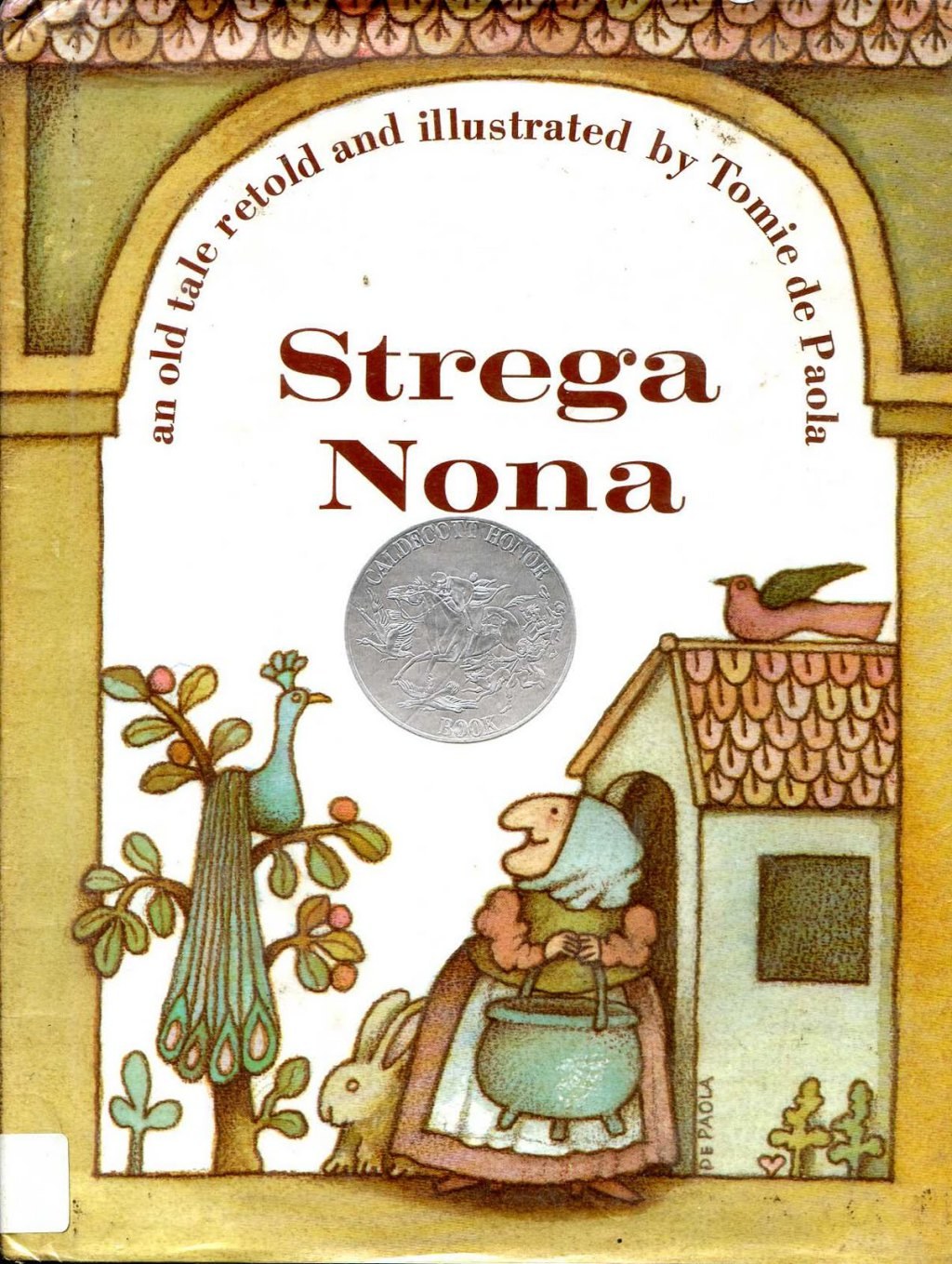
Plot: Strega Nona takes place in Calabria, in the southern region of Italy. Stega Nona (translated from Italian as "Witch Grandmother") is well known and well liked in her small village. Her special remedies are used by the villagers for everything from love connections to wart removal. Realizing she's not getting any younger, Strega Nona hires an assistant named Big Anthony to help her with household tasks. However, due to Big Anthony's inability to "pay attention" he incorrectly performs a spell while she is out of town. His attempt to provide pasta to the villagers works a little too well and soon the entire town is overrun with a plethora of pasta with no signs of stopping. Will Strega Nona return to the village in time to save everyone? Will the the magic pasta pot ever stop producing pasta? Will Anthony be punished? 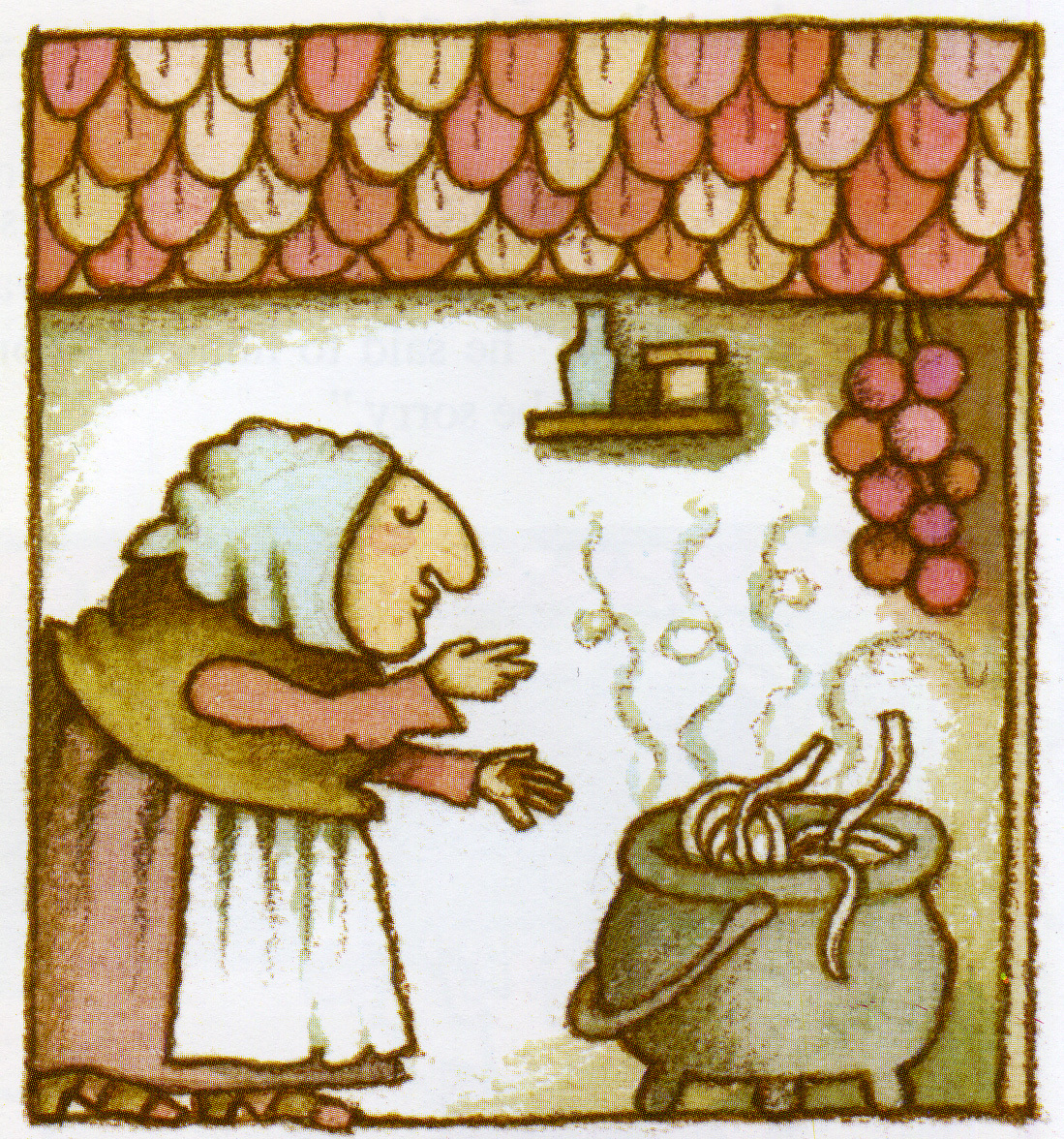 Will he learn his lesson? Respect, listening, consequences and kindness are all lessons learned through dePaola's recognizable and humorous illustrations and dialogue.
Will he learn his lesson? Respect, listening, consequences and kindness are all lessons learned through dePaola's recognizable and humorous illustrations and dialogue.
Misc: Only two books published in 1974 were honored in 1975. The winner, Arrow to the Sun by Gerald McDermott and the sole runner up Jambo Means Hello: A Swahili Alphabet Book by Tom Feelings. The 1976 list, which honored the crop of books published in '75 only increased the list to three. Strega Nona was named the runner-up along with Peter Parnall's The Desert is Theirs. The winners were husband and wife team Leo & Diane Dillon for Why Mosquitos Buzz in People's Ears, a book that translated several African legends. The Dillons would also be awarded the Caldecott in 1977 for their more in-depth look at those legends in Ashanti to Zulu: African Traditions. dePaola, who taught art at several institutes of higher learning including New England College and Colby-Sawyer College in New Hampshire before devoting himself full-time to children's books, has published over 120 works - 11 of which are Strega Nona stories (including Strega Nona Meets Her Match, Strega Nona Takes a Vacation and Strega Nona's Magic Lessons.) Though "Strega Nona" and the characters are wholly original characters created by dePaola, the general plot is an update of the Germanic fairytale, The Magic Porridge Pot. dePaola, who still resides in New London, NH, was honored by being named the U.S. nominee for the international Hans Christian Andersen award and was named the recipient of the Laura Ingalls Wilder award in 2011.
Availability: Strega Nona is available in hardcover, paperback, board book, digital and audio formats.
Finding the Summer in STEAM
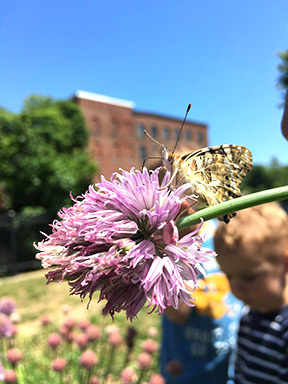 by Sarah Terry, Museum Educator
by Sarah Terry, Museum Educator
Could it finally be summer in New Hampshire? This winter child is a little sad (and hauling up the air conditioners from my basement…), but it’s hard to feel too badly when all the trees and flowers are in bloom!
I’ve been watching our museum garden start to grow out back – we have a ton of different herbs, all kinds of vegetables poking their stems up – and contemplating my unfortunate black thumb. I’ve never really been able get anything to grow except aloe plants (which apparently thrive on neglect), so I’ve been thinking a lot about the science behind growing things, the way plants and animals fit into their environments, and the effects, both positive and negative, that human beings can have on those environments.
It’s with those thoughts in mind that I’ve decided it’s high time to dirty up our fancy new STEAM Lab a bit! For the month of June, all of our lab activities are going to be focused on ecology.
I chose ecology in particular because it focuses on how all the elements of our environment work together. Ecologists look at plants, animals, soil, people – all the pieces of the puzzle. That’s what I’m hoping kids and parents will get a taste of in the lab this month.
And taste may be literal! I’m planning on growing some oyster mushrooms in the lab for kids to inspect, as well as planting some pea plants. We’ll be looking at strawberry DNA, making seed bombs, learning about beavers, making biomes in a bag, and even raising some butterflies!
We’ll be posting our STEAM Lab schedule weekly, so make sure to check our Facebook page and calendar for updates!
And who knows – maybe I’ll even get to upgrade my black thumb to something a little greener! Wish me luck!
New STEAM Programs
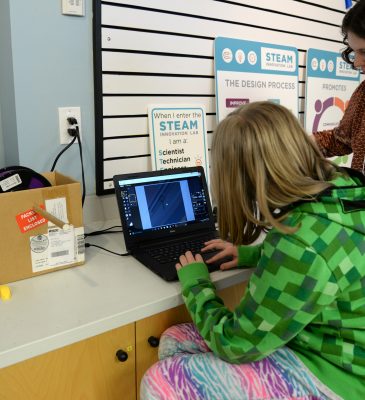 The Science, Technology, Engineering, Arts and Math (STEAM) Innovation Lab at the Children’s Museum of NH is now a permanent part of the museum and for the last few weeks has been hosting drop-in events every day. The Lab is designed to provide students, teachers and visiting families with enriching hands-on STEAM learning experiences.
The Science, Technology, Engineering, Arts and Math (STEAM) Innovation Lab at the Children’s Museum of NH is now a permanent part of the museum and for the last few weeks has been hosting drop-in events every day. The Lab is designed to provide students, teachers and visiting families with enriching hands-on STEAM learning experiences.
“The response has been wonderful!” shared Jane Bard, President of the Children’s Museum of NH. “We’ve had schools, teachers, and kids of all ages use the STEAM Lab, and with each new interaction, we feel confident that we’ve created a useful and timely resource.” Programs in the STEAM Innovation Lab can be tailored to any group.
Learning Labs are for schools and organized groups and come with themes like “Keeping Current: Circuits” or “Mission to the Moon.” New spring and summer classes and camps for kids are being scheduled now and some of those themes include “Sci Fi Science” and “Learn to Code.” The Children’s Museum educators are gearing up to offer Professional Development opportunities for teachers with workshop themes like “NGSS Crosscutting Standards: What Are They and How Do I Incorporate Them?” The Museum is currently partnering with UNH Cooperative Extension to offer “Inquiry Teaching Methods: Grounding STEM Education Programs in Science Practices” to 17 classroom educators from throughout the region.
Debuting at the Museum’s Earth Day Celebration on April 22 will be a new “Eco Boys and Girls Science Bites” program. CMNH has partnered with Eco Boys and Girls to create a series of 12 hands-on science demonstrations and activities featuring five lovable animated characters, each designed to educate pre-K to third grade children about the Earth, sustainability and our interconnectedness. Ernie Earth preserves the natural world and its ecosystems; Lulu Love demonstrates the importance of loving herself, others and all living things; Patsy Peace resolves conflicts so that humans and other living things can exist in peaceful ways; Ray Recycle shows people ways to reuse, reduce and recycle, and Sammy Sun spreads the word about conservation and protecting natural resources. These programs will be drop-in and free with museum admission. The lessons will also be available on the Museum’s website for free use in classrooms, after school programs or by families at home.
The STEAM Innovation Lab doesn’t get much quiet time because every day the museum is open, there is a scheduled drop-in activity included with admission so that guests of all ages can experience this unique space. Some programs encourage kids and parents to work together to build a prototype of an invention. Other programs lead kids through an engineering challenge to build boats, bridges or towers. Much of the Lab’s focus is on problem-solving and coming up with creative solutions. Other days visitors will be engaged with the Lab’s technology like the 3D printer and the FLoid® Imaging System microscopes provided by Thermo Fisher Scientific, one of the Lab’s legacy sponsors. Check our daily calendar on the Museum’s website: www.childrens-museum.org
In addition to all the daily drop-in programs that are free with museum admission, there are also programs that may cost a little extra to attend, but are perfect opportunities for adults and kids to learn together. Storybook STEAM happens most Fridays 2-2:45pm and is perfect for ages 3.5-5. Kids hear STEAM-related stories, read by a Museum educator, and then work with their adults on a project inspired by the story. Storybook STEAM doesn’t require registration and is $10 per adult/child pair for Members and $12 for adult/child pair for Non-members. There are also adult and child workshops on one Saturday a month called “STEAM Saturday Workshops,” The latest one is this coming Saturday, April 16 from 10:30-11:30am. Kids and adults can create their own Shrinky Dinks Sculptures to take home! On Saturday, May 14 from 10:30-11:30am adults can learn how to code their own video games right along with their kids (ages 8-12)! The cost for workshops like these is $15 per adult/child pair for Members and $20 for Non-members. (Does not include Museum admission.)
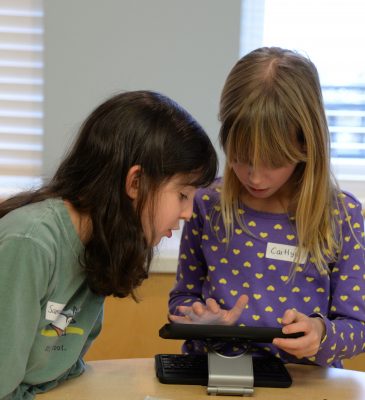 To help facilitate these kinds of coding workshops, the Children’s Museum has partnered with local software developer, James Terry, to create the museum’s first app. The “CMNH Game Maker” app has been developed to be used on the STEAM Innovation Lab’s iPads and allows users to switch seamlessly between coding, creating art, debugging, and testing their own video games. “Our goal with CMNH Game Maker is to provide a single tool that lets students (and interested adults) have everything they need to create their first video game,” shared Museum Educator (and James’ daughter) Sarah Terry. The app is currently being Beta tested by enthusiastic museum students throughout the spring. “Sarah and I are learning a lot watching the kids use the App and it’s given us a lot of ideas for new features and ways to make it even more accessible for kids who want to turn their passion for playing video games into the skill to make them," said James.
To help facilitate these kinds of coding workshops, the Children’s Museum has partnered with local software developer, James Terry, to create the museum’s first app. The “CMNH Game Maker” app has been developed to be used on the STEAM Innovation Lab’s iPads and allows users to switch seamlessly between coding, creating art, debugging, and testing their own video games. “Our goal with CMNH Game Maker is to provide a single tool that lets students (and interested adults) have everything they need to create their first video game,” shared Museum Educator (and James’ daughter) Sarah Terry. The app is currently being Beta tested by enthusiastic museum students throughout the spring. “Sarah and I are learning a lot watching the kids use the App and it’s given us a lot of ideas for new features and ways to make it even more accessible for kids who want to turn their passion for playing video games into the skill to make them," said James.
For more details and a schedule of events in the STEAM Innovation Lab, please visit our website. Thank you to our STEAM Innovation Lab founding sponsors Thermo Fisher Scientific, The Roger R. and Theresa S. Thompson Endowment Fund, Granite State Development Corporation and the Horne Family Foundation.
